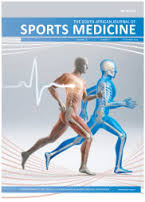Do upper leg compression garments aid performance and reduce exercise-induced muscle damage in recreational marathon runners?
DOI:
https://doi.org/10.17159/2078-516X/2022/v34i1a14169Abstract
Background: Despite the lack of scientific knowledge on the physiological and biomechanical effects of wearing compression garments (CGs), there has been an increase in the use of compression garments (CG) amongst endurance runners.
Objectives: To compare marathon race performance, post-race pain, and mid-thigh circumference in marathon runners using upper leg CGs, with runners who did not use CGs in the same marathon race.
Methods: The study was conducted on healthy, long-distance runners (n=18) participating in the Winelands Marathon race, Cape Town, South Africa. The CG group (n=10) participated in the race wearing upper leg CGs, while the control group (n=8) did not. Participants were tested on three occasions for various subjective markers of exercise-induced muscle damage (Visual analogue scale (VAS) pain rating score, and Likert scale for muscle pain), mid-thigh circumference for muscle swelling, and running performance (race pace).
Results: VAS pain ratings for hamstring (p=0.04), knee flexion (p=0.02) and hip extension (p=0.04) were significantly lower than the ratings of the control group immediately post-race and two days post-race. No statistically significant differences were detected in race performance, mid-thigh circumferences or Likert scale for determination of muscle soreness.
Discussion: Wearing of upper leg CGs while running a marathon race improved VAS pain ratings immediately post race through to two days post-race. However, due to no placebo control, this beneficial effect may be psychological as opposed to a physiological effect of the CGs on muscle pain.
Conclusion: The use of upper leg CGs reduced subjective muscle pain in runners in the first 48 hours post-race.
Downloads
Downloads
Published
Issue
Section
License
Copyright (c) 2022 South African Journal of Sports Medicine

This work is licensed under a Creative Commons Attribution 4.0 International License.
The South African Journal of Sports Medicine reserves copyright of the material published. The work is licensed under a Creative Commons Attribution 4.0 (CC BY 4.0) International License. Material submitted for publication in the South African Journal of Sports Medicine is accepted provided it has not been published elsewhere. The South African Journal of Sports Medicine does not hold itself responsible for statements made by the authors.
How to Cite
- Abstract 608
- PDF 471






.png)